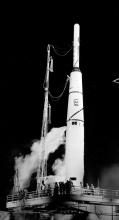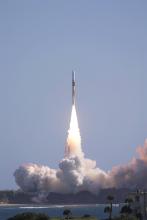Listen to today's episode of StarDate on the web the same day it airs in high-quality streaming audio without any extra ads or announcements. Choose a $8 one-month pass, or listen every day for a year for just $30.
You are here
Moon and Companions
The Moon will be busy over the next year or so. The United States plans to launch its first lunar landers since the Apollo missions of the 1970s. Russia and Japan plan to send their own landers. And several tiny satellites will enter orbit or fly past the Moon.
The American landers are being built by private companies. They’ll carry instruments from NASA, plus other payloads.
The first, Peregrine 1, will study how the craft itself affects the lunar surface, and look for evidence of water ice.
Both Peregrine and the second lander, Nova-C, will carry special mirrors to reflect laser beams from Earth. The experiments probe the Moon’s interior and test theories of gravity.
The Russian craft, Luna 25, will land near the south pole. It’ll study the Moon’s thin “atmosphere” — mainly a few atoms captured from the solar wind. Japan’s lander will test the technology for more complex missions in the future. And India and South Korea are preparing lunar missions as well.
The U.S. also plans to make the first test flight of a big new rocket. It’ll propel about a dozen “cubesats” to the Moon. They’ll conduct experiments and check out new technologies.
The missions are supposed to launch late this year or early next year — opening a busy new era for the Moon.
The Moon is in the west as night falls. The star Regulus stands to its lower left. Venus, the “evening star,” is to the lower right of the Moon, with tiny Mars beside Venus.
Script by Damond Benningfield






